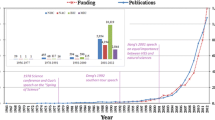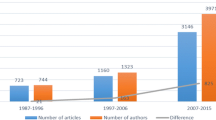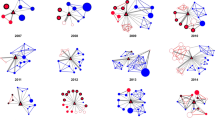Abstract
In this paper we analyze the evolution of China’s growing importance in international scientific collaboration over the past 15 years. Using co-authored publications indexed in Clarivate Analytics’s Web of Science Core Collection we develop novel weighted and unweighted centrality measures to quantify China’s emerging role in the global scientific research network. We analyze the networks formed by international co-authorship in three 5-year periods: 2001–2005, 2006–2010, and 2011–2015. This analysis highlights China’s sharp increase in prominence in international scientific collaborations. The analysis of China’s co-authored, highly cited papers also illustrates China’s rising importance in scientific research and collaboration from a different perspective. The impact of multilaterally co-authored papers to the centrality measure is also analyzed both theoretically and empirically. The results show that multilateral collaboration is also a key factor that influences the centrality of a country beyond simply the scale of international co-authorship. We further contextualize our work in a discussion of international scientific collaboration as both a key driver of China’s economy and its emerging perception as a first-world innovator and intellectual power. Finally, we suggest directions for further research including more granular analysis by academic discipline and an alternative investigation based on the fractional counting method.




Similar content being viewed by others
Notes
For example, the CNCI value of China’s domestic publications in the 5-year period 2011–2015 is 0.86, while the CNCI value of China’s internationally co-authored papers is 1.43, which is significantly higher than the global baseline 1.0.
Only when the first affiliation of the first author (according to the orders of authors in the paper by-line) or the first corresponding author is a Chinese affiliation, is the co-authored HCP regarded as an HCP with Chinese researchers as first or corresponding authors.
The reason we use the ten-year period 2008–2017 instead of 2006–2015 as we have previously in the paper is because: (1) The highly cited papers are now only available in the Web of Science for the recent eleven years 2007–2017. (2) The information for all authors is complete only from 2008 on.
References
Archambault, É., Beauchesne, O. H., Côté, G., & Roberge, G. (2011). Scale-adjusted metrics of scientific collaboration. Paper presented at the 13th International Conference of the International Society for Scientometrics and Informetrics (ISSI), Durban, South Africa.
Beaver, D. D. (2001). Reflections on scientific collaboration (and its study): Past, present, and future. Scientometrics, 52(3), 365–377.
Castelvecchi, D. (2015). Physics paper sets record with more than 5,000 authors. Nature.
Engardio, P. (2005). China is a private-sector economy. Bloomberg Businessweek.
Freeman, L. C. (1978). Centrality in social networks conceptual clarification. Social Networks, 1(3), 215–239.
Frenken, K., Hardeman, S., & Hoekman, J. (2009). Spatial scientometrics: Towards a cumulative research program. Journal of Informetrics, 3(3), 222–232.
Glänzel, W. (2001). National characteristics in international scientific co-authorship relations. Scientometrics, 51(1), 69–115.
Glänzel, W., & Schubert, A. (2001). Double effort = double impact? A critical view at international co-authorship in chemistry. Scientometrics, 50(2), 199–214.
Hand, E. (2010). ‘Big science’ spurs collaborative trend. Nature, 463, 282.
Hanneman, R., & Riddle, M. (2005). Introduction to social network methods. Retrieved from http://faculty.ucr.edu/~hanneman/nettext/index.html.
Hanneman, S., Wang, T., & Liefner, I. (2011). Measuring regional science networks in China: A comparison of international and domestic bibliographic data sources. Scientometrics, 88(2), 535–554.
Katz, J. S., & Hicks, D. (1997). How much is a collaboration worth? A calibrated bibliometric model. Paper presented at the 6th conference of the International Society for Scientometrics and Informetrics (ISSI), Jerusalem, Isreal.
Klochikhin, E. A. (2013). Innovation system in transition: Opportunities for policy learning between China and Russia. Science and Public Policy, 40(5), 657–673.
Leydesdorff, L., Bornmann, L., & Wagner, C. S. (2017). The relative influences of government funding and international collaboration on citation impact. arXiv.
Liu, X. Z., & Fang, H. (2014). Scientific group leaders’ authorship preferences: An empirical investigation. Scientometrics, 98(2), 909–925.
Narin, F., Stevens, K., & Whitlow, E. S. (1991). Scientific co-operation in Europe and the citation of multinationally authored papers. Scientometrics, 21(3), 313–323.
Niu, F., & Qiu, J. (2014). Network structure, distribution and the growth of Chinese international research collaboration. Scientometrics, 98(2), 1221–1233.
Nomaler, Ö., Frenken, K., & Heimeriks, G. (2013). Do more distant collaborations have more citation impact? Journal of Informetrics, 7(4), 966–971.
Qin, A. (2017). Fraud Scandals Sap China’s Dream of Becoming a Science Superpower. The New York Times. Retrieved October 30, 2017
Ribeiro, L. C., Rapini, M. S., Silva, L. A., & Albuquerque, E. M. (2017). Growth patterns of the network of international collaboration in science. Scientometrics.
Schubert, A., & Glänzel, W. (2006). Cross-national preference in co-authorship, references and citations. Scientometrics, 69(2), 409–428.
UNESCO. (2015). UNESCO science report: Towards 2030. Retrieved from https://en.unesco.org/unesco_science_report.
Wagner, C. S., & Jonkers, K. (2017). Open countries have strong science. Nature, 550(7674), 32–33.
Waltman, L., van Eck, N. J., van Leeuwen, T. N., Visser, M. S., & van Raan, A. F. J. (2010). Towards a new crown indicator: Some theoretical considerations. Journal of Informetrics, 5(1), 37–47.
Waltman, L., van Eck, N. J., van Leeuwen, T. N., Visser, M. S., & van Raan, A. F. J. (2011). Towards a new crown indicator: An empirical analysis. Scientometrics, 87(3), 467–481.
Wilson, R. J. (2012). Introduction to graph theory (5th ed.). Pearson.
Yuan, L., Hao, Y., Wu, D., Li, M., & Li, J. (2017). An analysis of international research collaboration based on research project data. In Proceedings of ISSI 2017—the 16th international conference on scientometrics and informetrics. Wuhan University, China, 1035–1051.
Zhang, Z., Rollins, J., & Lipitakis, E. (2017). The evolution of China’s role in the international scientific collaboration network. In Proceedings of ISSI 2017—the 16th international conference on scientometrics and informetrics. Wuhan University, China, 1052–1063.
Zhou, Y. (2015). The rapid rise of a research nation. Nature, 528(7582), S170–S173.
Zhou, P., & Glänzel, W. (2010). In-depth analysis on China’s international cooperation in science. Scientometrics, 82(3), 597–612.
Zitt, M., Bassecoulard, E., & Okubo, Y. (2000). Shadows of the past in international cooperation: Collaboration profiles of the top five producers of science. Scientometrics, 47(3), 627–657.
Acknowledgements
The present study is an extended version of a paper (Zhang et al. 2017) presented at the 16th International Conference on Scientometrics and Informetrics, Wuhan (China), 16–20 October 2017. Special thanks to Professor Ying Cheng at Graduate School of Education, Shanghai Jiao Tong University who gave valuable comments and suggestions in revising this paper.
Author information
Authors and Affiliations
Corresponding author
Rights and permissions
About this article
Cite this article
Zhang, Z., Rollins, J.E. & Lipitakis, E. China’s emerging centrality in the contemporary international scientific collaboration network. Scientometrics 116, 1075–1091 (2018). https://doi.org/10.1007/s11192-018-2788-5
Received:
Published:
Issue Date:
DOI: https://doi.org/10.1007/s11192-018-2788-5




